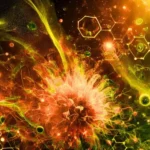Nanoparticles, the tiny wonders of the nanotechnology world, have opened up groundbreaking possibilities in medicine, electronics, and materials science. Yet, as we venture into this microscopic realm, addressing the potential risks of nanoparticle exposure becomes crucial. This comprehensive exploration delves into nanoparticle toxicity, uncovering its significance, underlying mechanisms, regulatory landscape, and the imperative to balance innovation with safety.
The Significance of Nanoparticle Toxicity
As nanotechnology advances, nanoparticle toxicity becomes a critical concern. The unique properties that make nanoparticles desirable for various applications also raise questions about their potential to harm human health and the environment. Understanding and managing nanoparticle toxicity is essential for responsible innovation.
Size Matters: Nanoparticle Characteristics
Due to their minuscule size, nanoparticle toxicity has a high surface area relative to their volume. This property grants them unique chemical and physical attributes, making them useful in applications like drug delivery and catalysis. However, it also means that they can interact with biological systems and the environment in ways that larger particles cannot, potentially leading to adverse effects.
Mechanisms of Nanoparticle Toxicity
The mechanisms of nanoparticle toxicity are complex and multifaceted. Nanoparticles can enter cells and tissues, disrupting normal cellular functions. They may induce oxidative stress, trigger inflammation, and even damage DNA. The specific mechanisms depend on various factors, including the nanoparticle’s size, shape, surface chemistry, and duration of exposure.
Regulatory Landscape and Safety Assessment
To ensure the responsible development and use of nanoparticle toxicity, regulatory agencies worldwide have begun to address nanoparticle safety.
Regulatory Oversight
Regulatory agencies, such as the U.S. Environmental Protection Agency (EPA) and the European Chemicals Agency (ECHA), are actively working to establish guidelines for nanoparticle safety. These agencies aim to balance the potential benefits of nanotechnology with the need to protect human health and the environment.
Safety Assessment
The safety assessment of nanoparticles is a complex process that involves evaluating their potential risks and benefits. Researchers use in vitro and in vivo studies and computational modeling to understand how nanoparticles interact with biological systems. This assessment informs decisions about their safe use in various applications.
Applications and Risks
Nanoparticles have found applications across diverse fields, each with its potential risks.
Medicine and Drug Delivery
In medicine, nanoparticles have revolutionized drug delivery, diagnostics, and imaging. They offer the potential for targeted therapies that enhance the efficacy of treatments while minimizing side effects. However, using nanoparticles in medicine also necessitates carefully evaluating their long-term safety to ensure that the benefits extend to patients without unintended consequences.
Electronics and Nanoelectromechanical Systems (NEMS)
In electronics, nanoparticles are integrated into semiconductors and nanoelectromechanical systems. Their inclusion in these applications can significantly enhance device performance and functionality. However, the widespread adoption of nanoparticles in electronics also raises concerns about electronic waste and potential environmental exposure, emphasizing the importance of responsible disposal and recycling practices.
Environmental Impact
Nanoparticles have the potential to enter the environment through various pathways, including wastewater discharge and industrial processes. Once released into ecosystems, they may impact aquatic life and terrestrial organisms. Addressing the environmental impact of nanoparticles is imperative for safeguarding ecosystems and preserving biodiversity.
Safety and Risk Mitigation
Efforts to mitigate the toxicity of nanoparticles encompass safer design principles and protective measures.
Safer Nanoparticle Design
Safer nanoparticle design revolves around engineering nanoparticles with reduced toxicity while preserving their functionality. Researchers are actively exploring strategies such as surface modifications and coatings to mitigate the potential adverse effects of nanoparticles. These innovative approaches aim to strike a balance between harnessing nanoparticles’ advantages and ensuring their safety.
Protective Measures
Protective measures are pivotal in reducing workers’ risks in occupational settings where nanoparticle exposure is a concern. Personal protective equipment and engineering controls, such as containment systems and ventilation, are essential safeguards that minimize the potential for inhalation or dermal exposure.
Risk Communication
Effective risk communication is paramount to ensure that stakeholders, including the general public, know the potential risks of nanoparticles. Transparency and accessibility of information empower individuals to make informed choices regarding their interactions with nanoparticles. This open dialogue fosters responsible decision-making and enhances public awareness of nanoparticle safety.
The Future of Nanoparticle Safety
As nanoparticle toxicity advances, nanoparticle safety will remain a pivotal consideration.
Advances in Safety Assessment
Continued research into the mechanisms of nanoparticle toxicity will lead to more accurate and comprehensive safety assessments. This growing knowledge base will inform the development of safer nanoparticles and influence the formulation of regulations and guidelines governing their use.
Responsible Innovation
The future of nanoparticle safety hinges on responsible innovation. Researchers, industries, and regulatory bodies must collaborate closely to strike a harmonious balance between harnessing nanoparticles’ potential for progress and ensuring their safe and responsible utilization. This collaborative effort is essential to navigating the evolving nanotechnology landscape safely and sustainably.
Conclusion
Nanoparticle toxicity stands as a critical challenge in the dynamic realm of nanotechnology. As society harnesses the power of nanoparticles to drive innovation and solve complex problems, it is imperative to comprehend and mitigate their potential risks to human health and the environment. The profound significance of nanoparticle toxicity lies in its capacity to shape the trajectory of responsible nanotechnology development.
As our knowledge deepens, regulatory oversight and safety measures must evolve in tandem, ensuring that nanoparticles continue to propel scientific advancement while safeguarding the well-being of individuals and the planet. Nanoparticle toxicity underscores the imperative of achieving a harmonious equilibrium between innovation and safety in the age of nanotechnology.












